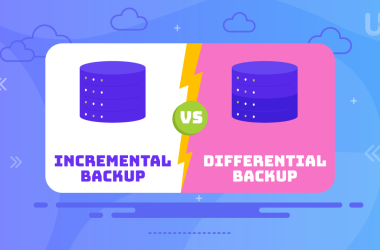Today, no organization or firm is exempt from the risks linked with data loss. Almost all organizations and businesses heavily rely on their tech infrastructure and data over the storage they place. The impact of an unforeseen disaster is extremely vital and has made the importance of Data Backups a priority in planning.
Recovery of data and vital system applications along with their data is made possible through the processes, policies, and tools that allow such recovery after a certain disruptive event. Disruptive events can be simple human error data loss, ransomware, or any other. A DPRP ensures data is recovered, however, focuses more on supporting business functions as soon as possible after an outage.
Understanding Disaster Scenarios
Different business activities will come with distinct types of disasters and risks involved in it. Each ranged disaster comes with it’s own set of risks. To plan a proper and reliable DRC one would start from extensive analysis of all the possible and plausible scenarios that could hold back the business from operating.
Different Types of Disasters
- Human Error and Accidents: Technology continues to improve but human elements remain a risk factor in many disaster scenarios. Data loss could stem from the deletion of the provided backup, misconfiguration, or some physical incident in the data center. Anticipating these human error possibilities and training employees, as well as limiting system access, are important parts of Disaster Recovery planning.
- Cybersecurity Threats: Ransomware attacks are a perfect example of cyber security danger in today’s interconnected world. Bad elements will stop (encrypt) an organization’s data and demand payment to unlock (decrypt) it. Having knowledge of cyber security threats is essential to develop working strategies to defend against malware attacks.
Impact of Disasters on Data and Business Operations

Data Loss
A Cyber attack or human injury, whether inflicted on purpose or not, makes clear the need for an efficient backup plan. Any number of reasons, from human intervention to cyber intrusions to even tangential violence, can lead to critical data loss. In addition, losing data poses a risk to customer loyalty, organizational productivity, or even corporate reputation, which brings about competitive market and invite regulatory scrutiny blatantly violating established standards. To recover lost data in modern digital settings, companies that strive for operational excellence collaborate with recovery solution specialists who ensure business process continuity by rapidly restoring data onto operational drive systems.
Downtime
The detrimental effect that a firm can suffer after prolonged stagnation from a service disaster is severely deep in terms of profitability and brand image. On top of that, in certain sectors where constant activity is mandatory, the implications of downtimes are unimaginably severe. The well-informed goal of Smart Disaster Recovery hopes to reduce downtime by achieving efficient data retrieval and restoration.
Financial Consequences
Financial losses are an immediate concern whenever disasters strike. Lost profits, recovery expenses, compliance penalty costs, and damage control are some of the finance-related expenses. Lost reputational damage, customer loyalty, and weak market position are also long-term consequences. Evaluating these impacts is essential to make certain that disaster recovery strategies are incorporated into the business at every level.
The Role of Data Backups
In terms of paradigm shifts like disasters occurring in Recovery from Data center scenarios, Data back up is unquestionably the most important part of preparation an organization can do.
Creating Copies of Critical Data
Meaning of backing up files is creating additional copies of important documents vital to any organization. Backing up data is not just duplication of routines, rather ensuring clearness and completeness of the organization’s data to allow the rebuilding of its essential framework due to crises. In addition, businesses calm themselves these days by saying they are protecting their data, thereby knowing full well that th essentinal information do aid the daily operations most certainly in case of emergencies.
Storing Backups in Secure Locations
No less important than making the backup itself is considering the locations where data backup places for the data need to be stored securely. Placing the backups in secure offsite locations ensure protection from all the disasters that are meant to be avoided. Securing WordPress data backups has to go beyond fireproof safes for physical purposes and secure cloud storage.
Types of Data Backups
Full Backups
For the organization to conduct a Full Backup they have to copy the entire data of the organization at a specific interval. This is the most comprehensive backup method, but it is one of the most expensive in terms of storage space and resources needed. Moreover, full backups serve as a baseline for recovery, meaning everything will need to be accessible in the event a restore is prompted so it can be available to the restore.
Incremental Backups
As the name suggests, incremental backups only include those changes that were made after the last backup was done to save more space. However useful this is in terms of resource consumption, restoring the information will require a lot of incremental backups to be done on top of the last backup done. This type of backup puts forth an equilibrium between resource utilization and the retrieval process.
Differential Backups
Differential backups are like Incremental backups but do not rely on last backups. Each differential backup captures changes made since the last performed full backup which means they all depend on the cumulative changes made after the last full backup. Although needing more space than the differential, this approach provides a pathway that is not as extreme as full and incremental.
Supercharge Your Disaster Recovery Plan Today!
Explore our proprietary NVMe VPS solutions and strengthen your business data. Our automated backup solutions enable daily backups, full server snapshots and 1-click restore for your website.
Best Practices for Data Backup
Regular Backup Schedules
Data backup is only effective if performed periodocally. Having scheduled backups promotes data availability. Additionally, organization backups should consider the importance of the data and its level of volatility within the organization.
Verification and Testing
The efficiency of a system is directly linked and relies upon the routines put in place. In this instance, the system performs repetitive testing: ensures backups provide intended data, and drills verify recovery procedures. Regular validation improves confidence providing uninterrupted services while identifying issues that could delay restoration.
Offsite and Cloud Backups
Having multiple copies of a single file enhances its reliability. Storing backups on-site as well copies stored in separate locations or secure offsite makes data less exposed to physical threats. Particularly cloud storage enhances availability, protection, and flexibility aiding modern strategies for backing up files.
Implementing a Disaster Recovery Plan
The work involves creating and putting into action a detailed strategy which encompasses all areas of the organization for the practice of Disaster Recovery. This plan not only focuses on the recovery of data but also on the restoration of critical systems within the organization in a timely manner to allow the business operations to resume as quickly as possible.
In the context of the disaster recovery plan and security, an SSL certificate is also vital as it enhances the security of online transactions and the integrity of data. It guarantees that during the process of recovery, the restoration of digital operations will be seamless due to data encryption processes and transfer of data securely.
Developing a Comprehensive Disaster Recovery Strategy
Identifying Critical Systems and Data
The very first step to create a disaster recovery plan is to identify important systems and data with utmost attention to detail as that is where the weakness lies. This will require assessment of the firm to identify the components which are needed for smooth running of business operations. In addition, businesses can streamline their recovery strategies by classifying systems and data according to importance.
Prioritizing Recovery Processes
Not every system, every piece of data, and every type of entity has the same recovery process. A prioritization plan is extremely fundamental. Every comprehensive Disaster Recovery strategy and plan must stratify the recovery steps into various categories depending on the order of restoration, the severity of disruption on business activities, and where other processes are aligned. Also, this guarantees that there is proper allocation of resources starting with the most critical ones first.
Challenges in Data Backup and Disaster Recovery
Executing a plan for Data Backup and Disaster Recovery is always mandatory. However, organizations deal with numerous obstacles, which can dramatically impact the success of the strategies. One of the components that helps strengthen disaster preparedness is ensuring that there are DDoS protected VPS solutions. Addressing these challenges, especially those to do with cybersecurity, is vital if efforts being made towards fortifying disaster preparedness are to be effective.
Inadequate Backup Frequency
Too little or infrequent backups is a common problem when strategizing for Data Backup. Organizations tend to have the mindset that infrequent backups will help them, but in fact renders them susceptible to massive data loss in more fluid settings where information changes rapidly. Additionally, it’s fundamental to ensure that backup frequencies are consistent with the rate of data change so that the most vital and up-to-date information is protected.
Lack of Testing
Backups paired with Recovery processes need to be tested regularly if there is a solid Disaster Recovery plan in place. Some organizations tend to skip such processes thinking the mere existence of backups is enough. Without periodic testing, the recovery processes remain untested and can lead to challenges and delays during a real disaster scenario.
Ignoring Human Factors
The presence of people is an inherent risk, but one organizations tend to miss out on include factors relating to people. A victim of insufficient training, too loose containment policies or lack of awareness surrounding the Disaster Recovery renders organizations vulnerable. On top of that, not taking into consideration such elements can lead to unintentional data deletion or slow down actual data recovery processes.
Cybersecurity Challenges
The changing world brings new possibilities, new technologies, as well as new forms of cyber crimes. The cyber world holds every type of danger imaginable. Outdated data protection technologies will become useless before sophisticated forms of cyber hijacking – ransomware and advanced persistent threats (APTs) – sophisticated long-term branch attacks. Resources are put under control, and barriers must be lifted too. Therefore, their defense system must permanently adapt. Besides, the relationship between cybersecurity and web hosting is very important because cyber threats can affect the security and availability of the data.
Conclusion
In short, having strong Disaster Recovery Procedures and Backup Plans Documents permits hindrance resilient dealing with organization changes. Turns of events, unforeseen risks in a world full of unpredictable events. These forces spell doom for several enterprises. However, in the event of often turns contrary to what is believed, strategically looks forward to infrastructure serves as a shield for achieving uninterrupted operational stability and business continuity.
For worry-free scheduled backups, stay protected with Ultahost’s WordPress Hosting with automatic daily backups and 24/7 access to our on-hand support team. We pride ourselves on highly specialized, auto-scaling, performance focused, secure infrastructure.
FAQ
How often should organizations test their Disaster Recovery plans?
Organizations should test their Disaster Recovery plans regularly to ensure the functionality of backup and recovery processes. Moreover, testing helps identify potential issues and ensures a smooth recovery in actual disaster scenarios.
What is the significance of Data Backups in Disaster Recovery?
Data Backups play a pivotal role in Disaster Recovery by creating duplicate copies of critical information. This ensures that, in the event of a disaster, organizations can restore lost or compromised data, reducing the risk of data loss and facilitating a quick return to normal business operations.
Why is Disaster Recovery essential for businesses?
Disaster Recovery is crucial for businesses to ensure continuity in the face of unforeseen events such as natural disasters, cyber threats, or human errors. It involves comprehensive strategies to recover critical systems and data swiftly, minimizing downtime and financial impact.
Why is offsite and cloud backup important in Disaster Recovery?
Offsite and cloud backups provide additional layers of protection by storing duplicates of data in secure locations. Moreover, this ensures data integrity and availability, even in the face of physical disasters affecting on-premises infrastructure.












